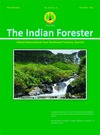Infestation of Termite in Progeny Trial of Tecomella undulata
DOI:
https://doi.org/10.36808/if/2016/v142i11/105621Keywords:
Chlorpyrifos, Insecticides, Tecomella undulata, Termite Infestation.Abstract
Termite damage is a serious problem in the establishment of forest plantations of many trees, as they have severely disrupted the ecological system and caused significant economic damage. They travel up through the roots into the trunk and branches and eventually disrupt the movement of nutrients and water through the vascular system resulting in wilting and drying of the tree. The study was conducted to assess the damage done by termites on Tecomella undulata field trial. At the age of five years, progenies attend an average height of 176cm and an average collar diameter of 2.57cm respectively. Results reveal the superficial infestation of termite upto the bark level ranging from 0.40m to 1.30m height of the trees during the long dry winter (October - February). For the management of termite infestation, an organophosphate insecticide Chlorpyrifos @1.5ml/litre was used with a repetition at an interval of one month. It was found that this dose could effectively control re-infestation of the termites for nearly five months.References
Bhandari M.M. (1990). Flora of Indian desert. MPS Repros Jodhpur, India. pp. 42.
Cowie R.H., Logan J.W.M. and Wood T.G. (1989). Termite (Isoptera) damage and control intropical forestry with special reference to Africa and Indo-Malaysia: A review, Bulletin Entomology Research, 79: 173-184.
Gould M.S., Lowe A.J. and Clarke G.P (1993). The Frequency of termite (Isoptera) damage to tree species in Namakutwa Forest, Tanzania, Sociobiology, 23(2): 189-198.
Harris W.V. (1971). Termites, their recognition and control, 2nd edn. Longmans, London, 186 p.
Jasmi A.H. and Ahmad A.H. (2011).Termite Incidence on an Araucaria plantation forest in Teluk Bahang, Penang, Insects, 2: 469-474.
Jindal S.K., Kackar N.L., Solanki K.R. (1987). Germplasm collection and genetic variability in Rohida (Tecomella undulata (Sm.) Seem) in western Rajasthan. Indian J. Forestry, 10: 52-55.
Lobry de Bruyns L.A. and Conacher A.J. (1990). The role of termites and ants in soil modification a review, Australian J. Soil Research, 28:55-93.
Logan J.W.M., Cowie R.H. and Wood T.G. (1990). ' Termites (Isoptera) control in agriculture and forestry by non-chemical methods: A review', Bulletin of Entomological Research, 80(3): 309–30.
Mac Gregor W.D. (1950). Termites, soil and vegetation. Forestry Abstract, 12: 3-8.
Mandal B.K., Bashar Kabirul, Howlader A.J. and Rahman K.M.Z. (2010). Incidence of termite infestation to tree species in Jahangirnagar University Campus, Bangladesh, Bangladesh, J. Life Science, 22(2): 7-15.
Nagaveni H.C., Remadevi O.K., Sharma M.N. and Rao R.V. (2002). Studies on the durability of plantation grown Tecomella undulata (Sm.) Seem, J. the Timber Development Association of India, 48(1/2):32-36.
Nair K.S.S. and Varma R.V.(1985).Some ecological aspects of the termite problem in young eucalypt plantations in Kerala, India, Forest Ecology and Management, 12:287-303.
Nyeko P. and Nakabonge G. (2008). Occurrence of pests and diseases in tree nurseries and plantations in Uganda a study commissioned by the sawlog production grant scheme (Spgs), Makerere University, Uganda.
Pardeshi M. and Prusty B.A.K. (2010). Termites as ecosystem engineers and potentials for soil restoration. Current science, 99: 11-11.
Parihar D.R. (1994). Termite management in arid zone of Rajasthan, India, Pest Management and Economic Zoology, 2(1):81-84.
Parihar D.R. (1981). Termite pests of vegetation in Rajasthan and their management.In: CAZRI Monograph No. 16. Published by the Director, Central Arid Zone Research Jodhpur,1-37.
Perry D.H., Lenz M. and Watson J.A.L. (1985). Relationships between fire, fungal rots and termite damage in Australian forest trees, Australian Forestry, 48: 46-53
Sands W.A. (1973). Termites as tree and crop pests Mededlingen Fakulteit Landbouwwentenschappen. Gent, 38:817-830.
Sen Sarma P.K. (1986). Economically important termites and their management in the Oriental Region. In: Economic impact and control of social insects (Vinson, S.B. Ed.), Praeger, New York, p. 69-102.
Singh R.P. (1992). On factors affecting clonal propagation of Anogeissus rotundifolia, Prosopis cineraria and Tecomella undulata, Ph.D Thesis, Jai Narain Vyas University, Jodhpur, India,
Varma R.V. and Nair K.S.S. (1997). Evaluation of newer termiticides including plant products for forest plantation establishment, KFRI Research Report, 127, pp 1-24.
Williams D.F. (1994). Exotic Ants: Biology, Impact and Control of Social Introduced Species, Boulder, Co., West view Press, USA, pp: 332.
Wood T.G. (1979). The termite (Isoptera) fauna of Malaysian and other tropical rain forests. In: The abundance of animals in Malesian Rain Forests (Marshall, A.G. Ed.). 113-130.
Wardell D.A. (1987). Control of termites in nurseries and young plantations in Africa: Established practices and alternative courses of action, Commonwealth Forestry Review, 66(1):77–89.
Downloads
Downloads
Published
How to Cite
Issue
Section
License
Unless otherwise stated, copyright or similar rights in all materials presented on the site, including graphical images, are owned by Indian Forester.





